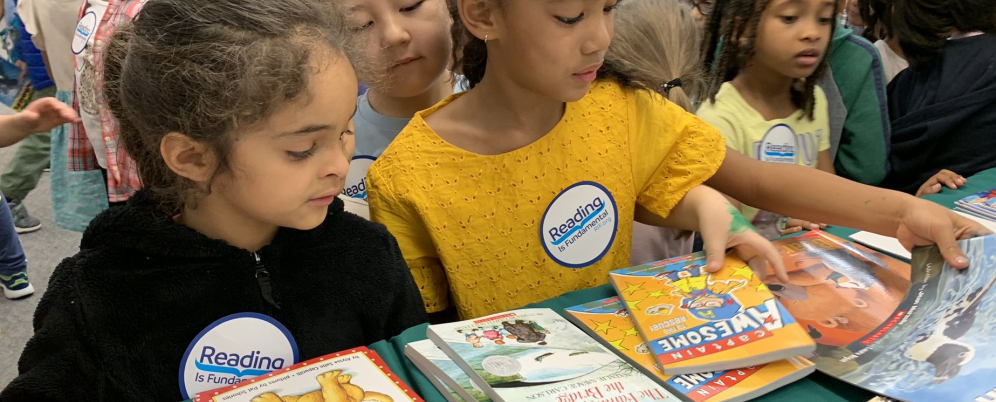AI and Reading Education: Unlocking Opportunity for Every Child
At Reading Is Fundamental (RIF), our mission has always been clear: to ensure that every child has the opportunity to experience the joy and power of reading. As technology evolves, so does our ability to reach children where they are, and today, that increasingly includes the digital world.
Artificial intelligence (AI) is reshaping nearly every aspect of education, and reading is no exception. While books remain at the heart of what we do, new AI reading tools personalize, expand, and enrich the reading experience in ways that were unimaginable just a few years ago.
To unpack this moment of both promise and caution, we sat down with Alicia Levi, RIF’s President and CEO, to explore how AI can help unlock literacy for all learners, if used responsibly and equitably.
1. What is the most promising use of AI in reading education?
AI’s greatest promise lies in personalization at scale. Every child’s reading journey is unique, and AI reading tools can adapt, instantly adjusting text difficulty, suggesting the right books, or providing comprehension support when a student struggles.
It starts with engagement, ensuring children see themselves and their experiences in the books and reading resources they choose. For a child who might need a little extra help, that means tailored guidance in real time. For a child ready to soar, it means new challenges that keep them engaged. And for teachers, it means meaningful insights that guide instruction.
Perhaps most importantly, AI-powered personalization can be transformative for underserved students, offering the kind of individualized reading journey that too often depends on access.
2. How can AI help close literacy gaps for the most underserved students?
AI reading tools can be a bridge to opportunity for children who don’t have access to rich print or digital literacy environments. Through AI-enabled platforms, students can explore diverse digital libraries, receive translation support for multilingual learning, or practice reading aloud with speech recognition tools that coach fluency.
When these tools are paired with community programs and access to physical books, AI becomes a powerful equalizer, extending quality literacy experiences to children who might otherwise be left behind.
3. What are the risks of AI deepening inequalities?
The risks are real. If only affluent schools or families can afford AI-powered literacy tools, the digital divide will widen. And because AI systems are built on data, any bias in that data can easily be reflected in the tools themselves, misrepresenting or excluding children and their stories.
That’s why equitable access and thoughtful design are essential. As we integrate AI into literacy, we must center fairness, inclusivity, and accessability. Reading is a fundamental right, and AI should amplify that right, not restrict it.
4. How do we ensure AI is culturally responsive?
Culturally responsive AI starts with representation. Every child should see themselves, literally and figuratively, in the stories they read and in the algorithms that recommend those stories.
That means investing in diverse content libraries, training AI on inclusive datasets, and working hand-in-hand with educators, parents, and communities to monitor how these tools are used. The goal isn’t just better technology, it’s helping every child find joy, identity, and connection through reading.
5. How is AI being used today by parents, educators, and children?
AI is already part of many literacy experiences, often without us realizing it:
- Parents: Think about read-aloud apps, speech-to-text tools, or digital platforms that recommend books based on a child’s interests.
- Educators: Teachers are using AI to differentiate lessons, tailor reading groups, and even translate communications for multilingual families, strengthening home-school partnerships.
- Children: Students are always ahead of the curve and our early adapters. They will teach us but we also want to steer them to impactful tools including Skybrary, adaptive reading apps, voice-based companions, and interactive storytelling platforms that make reading feel like play.
6. How can AI enhance educator effectiveness in teaching reading?
AI reading tools should empower, not replace, teachers. When used well, it takes administrative tasks off their plates so they can focus on what matters most: connecting with students.
AI can highlight which children need targeted phonics support, generate leveled text in seconds, or provide immediate feedback on reading fluency. By lightening the load, AI helps educators focus their energy where it counts, building confidence, curiosity, and comprehension.
7. What are the most common misconceptions about AI?
One common myth is that AI will replace teachers. It won’t. The human connection in teaching—the encouragement, the empathy, the spark—is irreplaceable.
Another misconception is that AI is automatically neutral. It’s not. AI mirrors the data it’s trained on, which means it takes human intention to ensure fairness and accuracy.
And finally, many people think AI is futuristic or out of reach, when in reality, it’s already woven into our daily lives. But it’s important to remember, AI is not a magic solution. The foundation of literacy still rests on the essentials: access to books, great teaching, and strong family engagement.
At Reading Is Fundamental, we believe that AI and human connection can work hand in hand to make reading more accessible, engaging, and equitable for every child. Technology should never replace the book in a child’s hands, it should help put more of them there.
Get Inspired—Read RIF's Blog
Stay connected with the heart of our mission by exploring our blog. We feature stories from communities we serve, literacy tips for educators and families, and updates on how Reading Is Fundamental is helping children across the nation discover the joy of reading.

